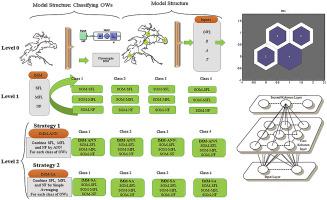Geoscience Frontiers ( IF 8.5 ) Pub Date : 2020-08-12 , DOI: 10.1016/j.gsf.2020.07.011 Rahman Khatibi , Ata Allah Nadiri

|
An explicit model management framework is introduced for predictive Groundwater Levels (GWL), particularly suitable to Observation Wells (OWs) with sparse and possibly heterogeneous data. The framework implements Multiple Models (MM) under the architecture of organising them at levels, as follows: (i) Level 0: treat heterogeneity in the data, e.g. Self-Organised Mapping (SOM) to classify the OWs; and decide on model structure, e.g. formulate a grey box model to predict GWLs. (ii) Level 1: construct MMs, e.g. two Fuzzy Logic (FL) and one Neurofuzzy (NF) models. (iii) Level 2: formulate strategies to combine the MM at Level 1, for which the paper uses Artificial Neural Networks (Strategy 1) and simple averaging (Strategy 2). Whilst the above model management strategy is novel, a critical view is presented, according to which modelling practices are: Inclusive Multiple Modelling (IMM) practices contrasted with existing practices, branded by the paper as Exclusionary Multiple Modelling (EMM). Scientific thinking over IMMs is captured as a framework with four dimensions: Model Reuse (MR), Hierarchical Recursion (HR), Elastic Learning Environment (ELE) and Goal Orientation (GO) and these together make the acronym of RHEO. Therefore, IMM-RHEO is piloted in the aquifer of Tabriz Plain with sparse and possibly heterogeneous data. The results provide some evidence that (i) IMM at two levels improves on the accuracy of individual models; and (ii) model combinations in IMM practices bring ‘model-learning’ into fashion for learning with the goal to explain baseline conditions and impacts of subsequent management changes.
中文翻译:

包含性多种模型(IMM),用于预测地下水位和处理异质性
针对预测的地下水位(GWL)引入了明确的模型管理框架,特别适用于具有稀疏数据和可能异构数据的观测井(OWs)。该框架在按层次进行组织的架构下实现了多个模型(MM),如下所示:(i)层次0:处理数据的异质性,例如自组织映射(SOM)来对OW进行分类;并确定模型结构,例如制定灰箱模型来预测GWL。(ii)级别1:构造MM,例如两个模糊逻辑(FL)和一个神经模糊(NF)模型。(ii)第2级:制定策略以组合级别1的模型,为此本文使用人工神经网络(策略1)和简单平均(策略2)。尽管上述模型管理策略是新颖的,但还是提出了一种批判性的观点,根据该观点,建模实践为:与现有实践形成对比的包容多重建模(IMM)实践,在本文中被冠以“排他性多重建模(EMM)”的商标。过整合管理模块科学思维被捕获作为具有四个尺寸的框架:型号ř尺寸EuSe(M - [R ),ħ ierarchical递归(ħ R),ê拉斯蒂克学习环境(Ë LE)和目标Ô rientation(G ö),它们一起成为RHEO的缩写。因此,IMB-RHEO在大不里士平原含水层中进行了稀疏且可能具有异构数据的试点。结果提供了一些证据,(i)两个级别的MM可以提高单个模型的准确性;(ii)IMM实践中的模型组合使“模型学习”成为流行的学习方式,目的是解释基线条件和后续管理变更的影响。











































 京公网安备 11010802027423号
京公网安备 11010802027423号